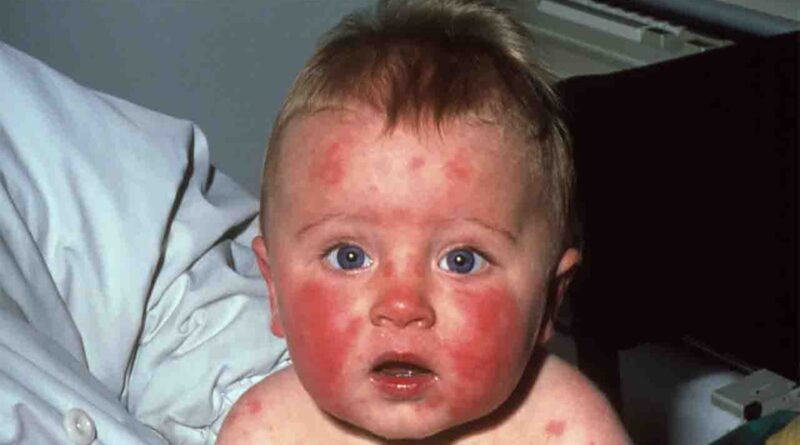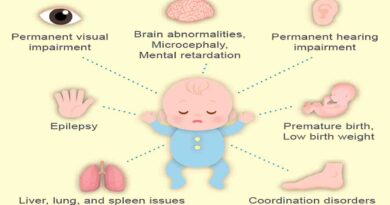Fifth Disease During Pregnancy
Pregnancy is a miraculous journey, but it comes with its unique set of challenges and concerns. One such concern is exposure to illnesses that can affect both the mother and the developing baby. Fifth Disease, caused by the Parvovirus B19, is one such condition that raises questions for expectant mothers. In this comprehensive guide, we will explore the nuances of Fifth Disease during pregnancy, including its risks, symptoms, and essential precautions.
Understanding Fifth Disease
a. Overview
Fifth Disease, also known as erythema infectiosum, is a common viral infection caused by the Parvovirus B19. While it is typically a mild illness in children, it can pose certain risks when contracted during pregnancy. Fifth disease is a very contagious viral illness that’s common in kids and is characterized by a “slapped cheek” rash. Fifth disease got its name because it used to be listed as a cause of childhood rash among several rash-causing diseases that are (mostly) rarer today, like measles and rubella.
b. How is it Spread?
Parvovirus B19 spreads through respiratory droplets and can also be transmitted through blood and other bodily fluids. Pregnant individuals can contract the virus through close contact with an infected person.
What causes fifth disease?
Fifth disease is caused by the parvovirus B19 (which, by the way, is not the same virus as parvovirus in dogs and cats). It’s spread through saliva or nasal secretions, often via coughs or sneezes, but also simply from close contact with a sick person.
The virus also spreads through blood, which means it can pass from a mom to baby during pregnancy, although it rarely causes complications. And once you recover, you usually develop immunity that prevents you from getting sick with fifth disease in the future.
What are the signs of fifth disease?
Many people don’t experience any symptoms of fifth disease. Those who do may or may not realize they’re sick with the virus, since symptoms are usually mild.
Fifth disease sometimes begins like a cold; this is the period when you’re most contagious. Signs usually show up about four to 14 days after you’re exposed to the virus and may include:
- Low-grade fever
- Runny nose
- Headache
- Fatigue
- Sore throat
- Muscle soreness
Fifth disease symptoms in kids
In children, the telltale sign of fifth disease is a bright-red rash on the cheeks that sometimes shows up six to 11 days after other symptoms. (They can look like they’ve been slapped.) Once your little one gets the rash, he’s usually no longer contagious.
A few days later, some kids get a slightly raised rash that starts on the chest and back and spreads to the butt, arms and legs. It can feel itchy, especially on the soles of the feet, and often has a lace-like pattern as it fades. It goes away in seven to 10 days, although the rash may come and go for weeks, tending to crop up when a child is hot from taking a bath or running around outside.
Fifth disease symptoms in adults
Adults with fifth disease are much less likely to get a rash but usually suffer from joint pain or swelling (or both) in the hands, wrists and knees. These symptoms usually resolve in one to three weeks, but they can last several months, though they rarely cause long-term problems.
It is important for patients to know that the virus is most contagious early on, seven to 10 days prior to a rash developing (if it does develop). That’s why it’s a good idea to reach out to your doctor right away if you think you may have been exposed to the virus.
How common is fifth disease?
Fifth disease is one of the most common childhood diseases. About half of all adults (including pregnant women) are already immune to fifth disease because they got sick with the virus in the past. It can affect people at any age, but is most common in children ages 5 to 15, with outbreaks usually occurring in the late winter and early spring.
Who is most at risk for fifth disease?
Anyone who isn’t immune to the parvovirus B19 from a previous fifth disease infection can catch it, although it causes mild (if any) symptoms in most adults and kids.
The virus can, however, cause complications for people who have anemia or weakened immune systems (from HIV or cancer, for example) as well as unborn babies whose moms contract the virus during pregnancy.
How can I prevent fifth disease during pregnancy?
To reduce the risk of infection, practice good hygiene, especially when you’re around small children:
- Wash your hands for 20 seconds with soap and water often throughout the day and especially after diaper changes and nose-blowings.
- Don’t share utensils or cups, especially with young kids.
- Avoid close contact with sick people.
- Don’t touch your eyes, nose or mouth with your hands.
What should you do if you contract fifth disease during pregnancy?
If you think you might have been exposed to fifth disease during pregnancy, call your practitioner right away. A blood test can show if you’re possibly immune to the virus from a previous infection or if you’ve been recently infected.
The good news is babies are very rarely affected when a mom contracts the virus that causes fifth disease during pregnancy. About half of adults are already immune to the virus, and most people who do get sick during pregnancy have mild symptoms.
In less than 5 percent of women who get sick with fifth disease during pregnancy, the virus can disrupt their baby’s ability to produce red blood cells.[3] This may lead to a form of serious anemia that can result in miscarriage or stillbirth. The risks to babies are greater if they’re infected during the first half of pregnancy.
If you do get sick with fifth disease during pregnancy, there is no antiviral medication to treat parvovirus B19. Fifth disease doesn’t require treatment unless you have risk factors like a weakened immune system or serious complications. Your practitioner will monitor your baby for complications with extra prenatal visits, ultrasounds and blood work.
Risks and Complications During Pregnancy
a. Impact on the Fetus
- Anemia: Fifth Disease can lead to a form of anemia in the developing baby, affecting red blood cell production.
- Hydrops fetalis: In severe cases, the virus may cause a condition known as hydrops fetalis, characterized by fluid accumulation in the baby’s body cavities.
b. Increased Risk in Certain Trimesters:
- First Trimester: The risk of severe complications appears to be higher if the infection occurs early in pregnancy.
- Third Trimester: Infection during the third trimester is less likely to cause complications but may still pose risks.
Symptoms of Fifth Disease
a. Common Symptoms:
- Rash: A distinctive “slapped-cheek” rash on the face is a characteristic symptom.
- Fever: Mild to moderate fever may accompany the rash.
- Body Aches: Joint pain and swelling are common symptoms.
b. Asymptomatic Cases:
- Some individuals, including pregnant women, may contract the virus and show no symptoms, making it challenging to detect and prevent transmission.
Diagnosis and Testing
a. Blood Tests:
- Blood tests can determine whether a person has been exposed to Parvovirus B19 by detecting antibodies.
b. Ultrasound:
- In cases where a Fifth Disease is suspected during pregnancy, ultrasounds may be recommended to monitor the baby for signs of complications.
Prevention and Precautions
a. Hygiene Practices:
- Handwashing: Regular and thorough handwashing is crucial, especially after being in close contact with individuals who may be infected.
- Avoidance: If possible, pregnant individuals should avoid close contact with anyone showing symptoms of Fifth Disease.
b. Workplace Precautions:
- Pregnant individuals working in environments where they may be exposed to Parvovirus B19, such as in healthcare or childcare settings, should discuss preventive measures with their healthcare provider.
Treatment and Management
a. Supportive Care:
- There is no specific antiviral treatment for the Fifth Disease. Management typically involves supportive care to alleviate symptoms.
b. Monitoring the Fetus:
- Pregnant individuals who contract Fifth Disease are closely monitored through ultrasounds to assess the baby’s well-being.
Communicating with Healthcare Providers
a. Timely Reporting:
- If a pregnant person suspects exposure to Fifth Disease or experiences symptoms, it is essential to communicate promptly with their healthcare provider.
b. Monitoring and Follow-Up:
- Regular check-ups and follow-up appointments help healthcare providers monitor the pregnancy and address any concerns promptly.
Emotional Support
Coping with Anxiety
A diagnosis of Fifth Disease during pregnancy can be anxiety-inducing. Seek emotional support from healthcare providers, friends, and family to navigate this challenging period.
Navigating Fifth Disease during pregnancy requires a combination of awareness, proactive measures, and open communication with healthcare providers. While the risks associated with Fifth Disease are present, timely diagnosis, monitoring, and appropriate care can significantly mitigate potential complications. If you suspect exposure or experience symptoms, do not hesitate to consult with your healthcare provider to ensure the best possible outcomes for both you and your baby.
Remember, information is empowering. Stay informed, stay vigilant, and prioritize your health and the health of your growing family.
For more information and resources on pregnancy-related topics, visit BestOfTheBump.com.
References
- Centers for Disease Control and Prevention, Fifth Disease Opens a new window, November 2019. | Show in the article
- American Academy of Pediatrics, Fifth Disease (Parvovirus B19) Opens a new window, November 2020. | Show in the article
- Centers for Disease Control and Prevention, Pregnancy and Fifth Disease Opens a new window, November 2019. | Show in the article
- What to Expect When You’re Expecting, 5th edition, Heidi Murkoff.
- WhatToExpect.com, Fever During Pregnancy, January 2021.
- American Academy of Family Physicians, Fifth Disease, October 2020.
- National Institutes of Health, National Library of Medicine, Erythema Infectiosum, August 2021.
- National Institutes of Health, National Library of Medicine, Exposure to Fifth Disease During Pregnancy, December 2009.
- Mayo Clinic, Parvovirus Infection, April 2022.
- KidsHealth From Nemours, Fifth Disease, February 2017.
- Cleveland Clinic, Fifth Disease, May 2020.
See this also –
- Gestational Diabetes and Pregnancy
- Positive Parenting Affirmations to Boost Your Mental Health
- Implantation Bleeding: When It Happens and What It Looks Like
- Using Makeup During Pregnancy Is Safe for the Little One?
- How Does Gestational Diabetes (GD) Affect Your Pregnancy and Baby?
- Makeup Ingredients to Avoid During Pregnancy
- Exposure to fifth disease in pregnancy – PMC




